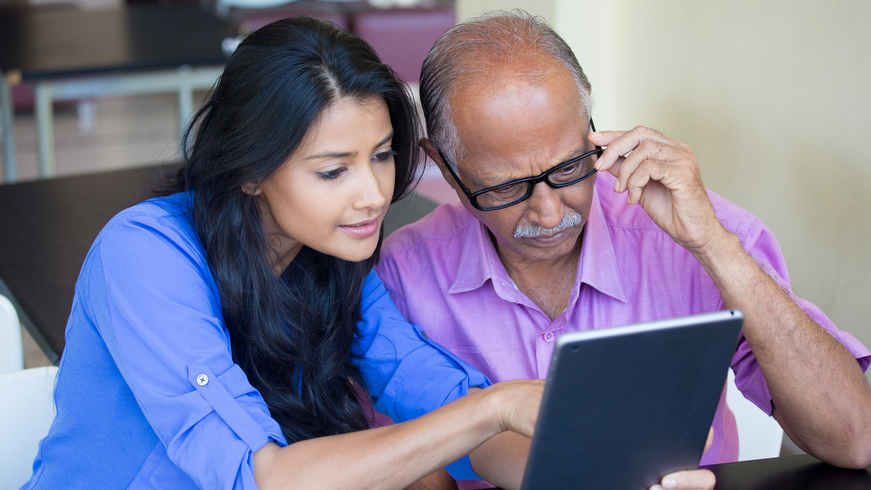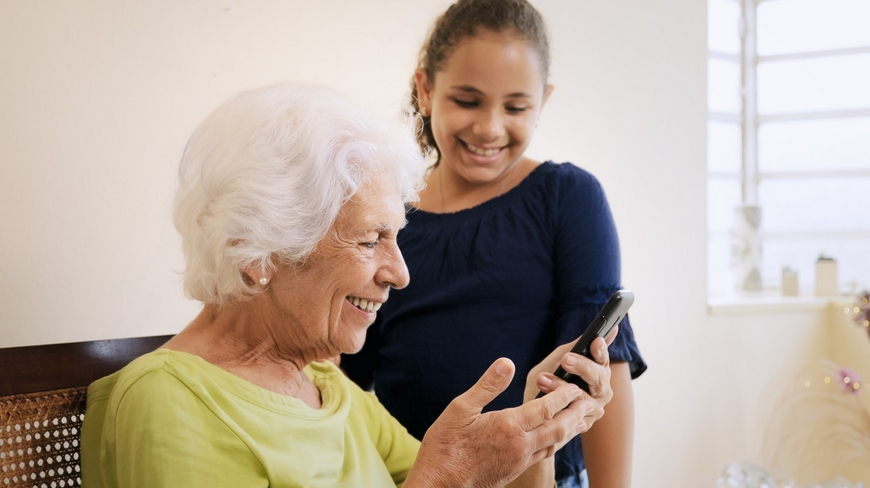Seniors and Technology: How to Help Seniors Get Comfortable with Devices

Technology has become an integral part of our daily lives in today’s digital age. From smartphones to tablets and computers, we rely on devices to communicate, access information, and stay connected with the world. However, for seniors who may not have grown up with technology, using smart devices can be intimidating and overwhelming. Many seniors struggle to navigate menus and interfaces and may feel afraid of breaking or damaging devices.
But the benefits of technology for seniors are too significant to ignore. Devices can help seniors stay connected with family and friends, access healthcare resources, and provide convenience and ease of use. This article will provide tips and guidance for helping seniors get comfortable with technology. Whether you are a caregiver or a senior yourself, this guide will provide valuable insights on how to navigate the world of devices and technology.
Benefits of Technology for Seniors
As we mentioned earlier, the benefits of technology for seniors are numerous. Here are some of the key ways that devices can enhance seniors’ daily living:
1. Staying Connected With Family and Friends
One of the most significant benefits of technology for seniors is the ability to stay connected with loved ones who may live far away. Social media platforms, video chat apps, and messaging tools can all make it easier for seniors to stay in touch with family members, friends, and even long-lost acquaintances. This can help reduce loneliness and isolation and provide a sense of community.
2. Access to Healthcare Resources
Another significant benefit of technology for elderly person is increased access to healthcare resources. With the rise of telemedicine and health monitoring devices, seniors can now access medical advice and support from the comfort of their own homes. This can be particularly helpful for those with mobility issues or who live in remote areas.
3. Convenience and Ease of Use

Technology can provide seniors with convenience and ease of use. From smartphones to tablets, many electronic devices are designed with user-friendliness in mind, making them easy to navigate and operate. This can help seniors complete tasks more efficiently and independently, such as banking, shopping, and accessing information.
4. Entertainment
Various entertainment option is also an advantage of technology for an elderly person, from streaming movies and TV shows to playing games and listening to music. This can be especially important for those unable to leave their homes due to mobility issues or other health concerns.
5. Improved Cognitive Function
Studies have shown that technology can help seniors improve their memory and cognitive function. Learning new skills, playing brain games, and staying mentally active through technology can help seniors maintain their mental agility and independence.
Reasons Why Seniors Won’t Embrace Technology

While technology has made significant strides in recent years and has proven helpful in many aspects of daily life, seniors may still resist using technology for various reasons. Here are some reasons why seniors may not embrace technology:
- Lack of Familiarity: Many seniors didn’t grow up with technology and, as a result, may feel uncomfortable using it. They may have a limited understanding of technology and find it daunting to learn something new.
- Fear of Breaking Something: Some seniors may worry that they will damage their devices or accidentally delete important information. They may not feel confident using new technology, which can lead to a fear of breaking something.
- Health Problems: Seniors may have health problems that limit their ability to use technology, such as arthritis or poor eyesight. Using small devices or typing on a keyboard may be difficult for them.
- Cost: Many seniors are on a fixed income and may not have the financial resources to purchase new technology or pay for internet services.
- Fear of Scams and Fraud: Seniors may be more susceptible to online scams or fraud, which can lead to distrust of technology.
- Lack of Interest: Some seniors may simply not be interested in using technology. They may prefer to stick with what they know and feel comfortable with.
- Lack of Social Interaction: Seniors may feel that using technology takes away from face-to-face interactions with family and friends. They may value personal connections over online interactions.
Tips for Helping Seniors Get Comfortable With Technology
There is no denying that seniors have their reasons why they may be hesitant to embrace technology. However, it’s important to note that technology can offer a wealth of benefits for seniors, and getting comfortable with technology is a worthwhile endeavor. Here are some tips to help seniors feel more at ease with technology and take advantage of its benefits:
1. Emphasize the Benefits

Start by discussing the many benefits technology can provide seniors, such as staying connected with family and friends, accessing important information, and even improving cognitive function through brain games and other apps.
For instance, if your senior loved one likes to read newspapers, explain how they can easily access their favorite publications online or through an e-reader device. Or, if they enjoy listening to music, introduce them to music streaming services that offer a wide range of songs and genres. This might make them more interested in exploring technology and realizing its potential benefits.
2. Be Patient and Encouraging
Learning new technology can be challenging, so it’s important to be patient and encouraging when helping seniors. Avoid criticizing or getting frustrated if they make mistakes or have trouble understanding a concept. Instead, offer positive feedback and support. For example, if a senior is struggling with sending a text message, you could say, “Great job! You’re getting the hang of it. Let’s try it again together.”
3. Use Simple Language
As our loved ones get older, their cognitive abilities and memory may decline, making it more challenging to understand and remember new information. This is why it’s important to use simple and clear language when explaining how to use technology to seniors. Using clear language can help seniors feel less intimidated and overwhelmed by new technology. Here are some ways you can make the language simpler:
- Instead of saying “GPS,” say “a tool that helps you find your way around.”
- You may say “the way your device connects to the internet without a cable.” instead of saying “Wi-Fi,”
- Instead of “Bluetooth,” say “a way your device connects to other devices, like headphones or speakers.”
Using analogies or real-world examples can also make concepts more relatable and easier to understand.
Here are some examples:
- When explaining how to use a touchscreen, you could use the analogy of a vending machine. Just like you would press a button on a vending machine to make a selection, you can touch an icon on a touchscreen to open an app or make a selection.
- When explaining how to use a mouse, you could use the analogy of remote control. Like you would move a remote control to point at the TV to change channels, you move a mouse to point at things on the computer screen.
- When explaining how to use email, you could use the analogy of a mailbox. Just like you would write a letter and put it in a mailbox to send to someone, you can compose an email and hit “send” to send it to someone’s email address.
Using simple language and analogies can make a big difference in helping seniors understand how to use technology. By breaking down concepts into relatable terms, seniors can become more confident and comfortable with devices and software.
4. Let Seniors Practice Themselves

While it is easy to present seniors with the steps to use technology, it is essential to let them practice on their own to get comfortable with devices. The fear of doing something wrong can prevent seniors from exploring and fully enjoying the benefits of technology. By encouraging them to practice and explore, they can gain confidence in their abilities to use the device, ultimately improving their quality of life.
To help seniors get comfortable with devices:
- Start by introducing them to the device’s basic functions, such as turning it on and off, accessing the internet, and using the built-in applications.
- Let them explore and experiment with the device on their own.
- Offer guidance and assistance when needed, but avoid taking over and doing everything for them.
5. Discuss Security
Another aspect of teaching an elderly loved one about technology is helping them navigate security. As seniors begin to embrace technology, discussing the importance of security is essential. For instance, discuss with them that they should never write down their password or username. Encourage them to use a strong password that is a combination of letters, numbers, and special characters. Explain to them that they should never share their personal information, such as credit card details or social security numbers, online unless it is a trusted website.
It is also important to discuss the importance of keeping their software up-to-date and avoiding clicking on suspicious links or downloading unknown attachments. By having these conversations, you can help seniors feel more comfortable and confident with their devices while keeping them safe from potential security threats.
6. Take it Slow

As your senior loved one becomes used to technology, breaking up the sessions and taking it slow is vital. For many seniors, technology can be overwhelming and intimidating. They may feel frustrated and discouraged if they can’t grasp a concept or function right away. That’s why starting small and introducing technology in manageable doses is important. Whether it’s a smartphone, tablet, or computer, seniors can benefit greatly from incorporating technology into their daily lives. But it’s crucial to go at their pace and ensure that they feel comfortable and confident before moving on to the next level.
One effective way to help seniors get comfortable with devices is to encourage them to use them for things they are interested in. Perhaps they enjoy reading, in which case a tablet or e-reader can be a great way to introduce technology. Start with the basics, such as how to turn it on, swipe to unlock, and navigate to the desired app. Once they feel comfortable with the basics, they gradually introduce new functions and features. Remember to be patient and allow plenty of time for practice and repetition. By breaking up the sessions and going slowly and steadily, seniors will gradually gain confidence and become more comfortable with technology.
8. Ensure Adjust Devices Meet Needs
Lots of elderly may need their phone or computer to be adjusted to meet their needs. For instance, if your senior has problems with their vision, adjusting the font size, contrast, and brightness can make a world of difference. Similarly, adjusting the volume or using headphones can help them hear more clearly if they struggle with hearing. It’s important to remember that seniors have unique needs when it comes to technology, and accommodating those needs can make all the difference in their comfort and confidence.
9. Provide Ongoing Support

Providing ongoing support is crucial in helping seniors become comfortable with devices. Learning new technology can be overwhelming, and seniors may forget some of the instructions. It’s important to be patient and offer continued support and assistance as they learn to use the device.
One way to provide ongoing support is to schedule regular check-ins to see how they are doing and if they have any questions or concerns. You can offer to help them troubleshoot issues they may encounter or provide resources like user manuals or online tutorials. By showing that you are available to offer assistance and support, seniors will feel more comfortable using their devices and will be more likely to continue exploring new technology.
Final Thoughts
Helping seniors get comfortable with devices is an important task that requires patience, understanding, and ongoing support. It’s important to remember that seniors may need additional time and assistance to learn new technology and that making mistakes along the way is okay.
If you are not always available to guide your loved ones in using their devices, you can rely on the help of a caregiver. A caregiver can provide one-on-one support and assistance to help seniors navigate their devices and troubleshoot any issues. It’s important to choose a caregiver from a reliable agency like Serenity Senior Care, which has a team of trained professionals experienced in assisting seniors with technology.
By providing ongoing support and resources, you can help seniors stay connected with loved ones, access important information, and enjoy the many benefits of technology. With patience, persistence, and the help of a caregiver, seniors can become confident and comfortable with devices and enhance their quality of life in the digital age.


